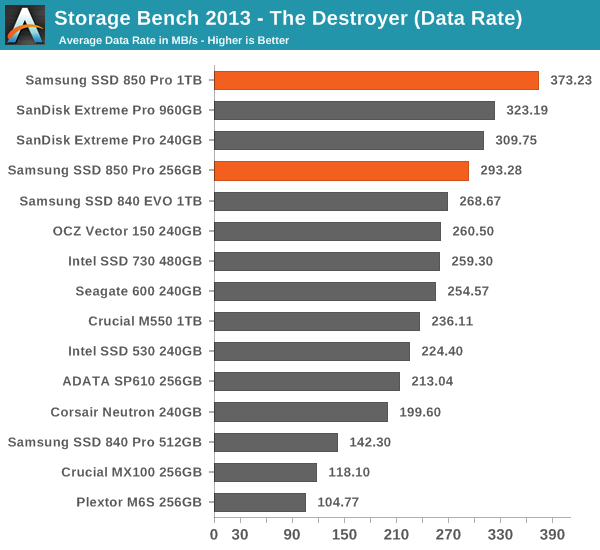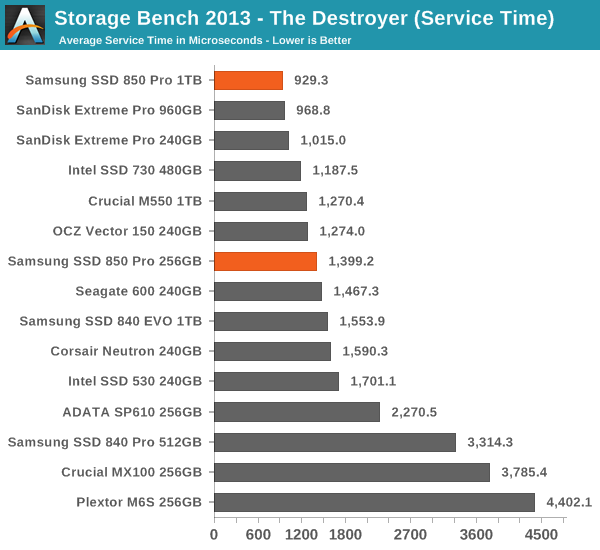Samsung SSD 850 Pro (128GB, 256GB & 1TB) Review: Enter the 3D Era
by Kristian Vättö on July 1, 2014 10:00 AM ESTAnandTech Storage Bench 2013
Our Storage Bench 2013 focuses on worst-case multitasking and IO consistency. Similar to our earlier Storage Benches, the test is still application trace based - we record all IO requests made to a test system and play them back on the drive we are testing and run statistical analysis on the drive's responses. There are 49.8 million IO operations in total with 1583.0GB of reads and 875.6GB of writes. I'm not including the full description of the test for better readability, so make sure to read our Storage Bench 2013 introduction for the full details.
| AnandTech Storage Bench 2013 - The Destroyer | ||
| Workload | Description | Applications Used |
| Photo Sync/Editing | Import images, edit, export | Adobe Photoshop CS6, Adobe Lightroom 4, Dropbox |
| Gaming | Download/install games, play games | Steam, Deus Ex, Skyrim, Starcraft 2, BioShock Infinite |
| Virtualization | Run/manage VM, use general apps inside VM | VirtualBox |
| General Productivity | Browse the web, manage local email, copy files, encrypt/decrypt files, backup system, download content, virus/malware scan | Chrome, IE10, Outlook, Windows 8, AxCrypt, uTorrent, AdAware |
| Video Playback | Copy and watch movies | Windows 8 |
| Application Development | Compile projects, check out code, download code samples | Visual Studio 2012 |
We are reporting two primary metrics with the Destroyer: average data rate in MB/s and average service time in microseconds. The former gives you an idea of the throughput of the drive during the time that it was running the test workload. This can be a very good indication of overall performance. What average data rate doesn't do a good job of is taking into account response time of very bursty (read: high queue depth) IO. By reporting average service time we heavily weigh latency for queued IOs. You'll note that this is a metric we have been reporting in our enterprise benchmarks for a while now. With the client tests maturing, the time was right for a little convergence.

Thanks to the excellent IO consistency, the 850 Pro dominates our 2013 Storage Bench. At the 1TB capacity point, the 850 Pro is over 15% faster than any drive when looking at the average data rate. That is huge because the 850 Pro has less over-provisioning than most of today's high-end drives and the 2013 Storage Bench tends to reward drives that have more over-provisioning because it essentially pushes drives to steady-state. The 256GB model does not do as well as the 1TB one but it is still one of the fastest drives in its class. I wonder if the lesser amount of over-provisioning is the reason or perhaps the Extreme Pro is just so well optimized for mixed workloads.











160 Comments
View All Comments
Homeles - Monday, June 30, 2014 - link
Man, the 850 Pro is killer. Samsung really knocked it out of the park. Those prices are just completely out of touch, though.Awful - Monday, June 30, 2014 - link
Yeah the prices are high for now. Game changing stuff though; and prices can only come down. PCIe V-NAND? Yes please!Hung_Low - Tuesday, July 1, 2014 - link
Even better, Intel style NVMe controller + this v-nand!! orgasmicavyshue - Tuesday, July 1, 2014 - link
yeah, i've been holding off on upgrading from my existing 128 boot drive + mechanical setup to a full 1TB drive. I think I'll keep holding out until PCIe is better supported/better priced.Angrychair - Tuesday, July 1, 2014 - link
The prices are in line for class leading performance and reliability.The reliability is the critical part, these are drives that are unlikely to wear out in any system almost no matter how heavily taxed.
Ken_g6 - Tuesday, July 1, 2014 - link
I see these are MLC drives. Hopefully, Samsung will come out with consumer-level 3D TLC drives that have relatively good reliability, and a price at or below Crucial's drives.frenchy_2001 - Tuesday, July 1, 2014 - link
Reliability is a side effect of retreating to 40nm pitch technology.Even if they decided to do TLC with the same cells, they would probably end up being more reliable than 2D nand MLC.
joelypolly - Thursday, July 3, 2014 - link
They already have drives in testing that has written over 8 petabytes so I think the reliability is theremkozakewich - Saturday, July 5, 2014 - link
On that note, I'm wondering how 4-bit MLC would perform compared to 2D NAND.RaistlinZ - Monday, June 30, 2014 - link
Fantastic drives! That consistency is really remarkable. I don't know if most will pay the price premium for these over the EVO however. The average user probably wouldn't notice a difference in general day to day use.